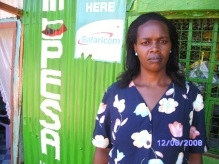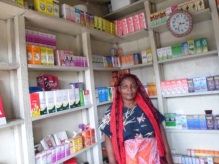Behind every small business, there’s a story worth knowing. All the corner shops in our towns and cities, the restaurants, cleaners, gyms, hair salons, hardware stores – these didn’t come out of nowhere – Paul Ryan.
I found Patrick Ngamaini’s story definitely worth knowing. Patrick is one of MYC4’s borrowers through our provider Premier Kenya. I met Patrick at his little shop in Kawangware and I must say I rather enjoyed my talks with this vivacious and ambitious businessman. It is clear to anyone who talks to Patrick that he has big dreams for himself and his business. He tells me that his small beginning is not a hindrance to his dreams but a motivation to attain financial freedom.
How did you hear about MYC4?
I heard about MYC4 in 2014 through the Premier Kenya, loan officer who came to explain to my investment group/chama how MYC4 works,
How has the MYC4 loan helped you?
The loan I received from MYC4 has helped me acquire the funds I needed to run my business. I use the funds to buy my stock of consumer goods which i restock frequently because they are fast moving items.
What problem were you facing that MYC4 have helped you to solve since you received the funds?
One problem I was facing was the lack of ready and available capital to run my small business especially with the stringent borrower demands that large financial institutions have put in place. These requirements usually do not favour us small entrepreneurs. However, since I received my funds I have been able to effectively run my shop and fulfill my customers needs.
Have the funds you borrowed increased your profits or income, and have you employed anyone?
Since I received the funds my business has been running well and I have a fair source of income.. The funds have allowed me to continuously have stock and continuously make sales. In my business of selling consumer goods especially on a small scale as I am currently doing, the profits do not immediately reflect, but with continued sales, I will eventually have a tidy sum. Currently, I cannot afford to employ anyone but I hope to be able to soon.
What did you like about MYC4? What is the experience of working with MYC4?
The one thing I have liked in the short time I have worked with MYC4, is that the funds were received within my preferred time-frame and I did not have to wait for an overextended period. Additionally the interest rate is fair and the duration given to make repayments is reasonable.
What would you like people to know about MYC4?
I would like to let people know that MYC4 helps many men and women to boost their small businesses. Whether you are starting or already running a small business and you have little funds, do not be discouraged, MYC4 can help you make your business dreams a reality.
Would you recommend MYC4 to your friends or family?
Definitely. Other than my group members, I also know of some men and women here in Kawangware as well who are benefiting from MYC4 loans.
Would you consider taking a second loan once you clear this loan?
I would. I would like to grow my business even more and possibly relocate to a bigger space, stock more goods and and eventually hire people to help with sales. If my business grows bigger, I would like to venture into other bigger, business industries such as real estate and transportation.
Do you have any additional comments?
I would like to thank MYC4 for the opportunity they give business people such as myself. MYC4 empowers us to grow and develop as people as well as business people and we urge you to continue supporting entrepreneurs. I would urge MYC4 to add more funds to trusted borrowers and to additionally finance investment groups as a whole.


























